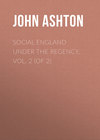Kitabı oku: «The Dawn of the XIXth Century in England», sayfa 24
CHAPTER XLVIII
The Army – Number of men – Dress – Hair-powder – Militia – Commissions easily obtained – Price of substitutes – The Volunteers – Dress of the Honourable and Ancient Artillery Company – Bloomsbury Volunteers, and Rifle Volunteers – Review at Hatfield – Grand rising of Volunteers in 1803.
IN THE year 1800, our Army consisted of between 80,000 and 90,000 men, besides the foreign legions, such as the Bavarians, in our pay. In 1810, there were 105,000, foreigners not included.
The British soldier of that day was, outwardly, largely compounded of a tight coat and gaiters, many buttons and straps, finished off with hog’s lard and flour; and an excellent representation of him, in the midst of the decade, is taken from a memorial picture of the death of Nelson, and also from his funeral; but these latter may have been volunteers, as they were much utilized on that occasion. Be they what they may, both had one thing in common – the pig-tail – which was duly soaped, or larded and floured, until flour became so scarce that its use was first modified, and then discontinued, about 1808. Otherwise the variety of uniforms was infinite, as now.
Of the threatened Invasion I have already treated. Of the glorious campaigns abroad I have nothing to say, except that all did their duty, or more, with very few blunders, if we except the Expedition to the Scheldt. From the highest to the lowest, there was a wish to be with the colours. Fain would the Prince of Wales have joined any regiment of which he was colonel, on active service, and, in fact, he made application to be allowed to do so, but met with a refusal, at which he chafed greatly. Should any one be curious to read the “Correspondence between His Majesty, The Prince of Wales, the Duke of York, and Mr. Addington, respecting the Offer of Military Service made by His Royal Highness the Prince of Wales,” it can be found in the appendix to the chronicle of the Annual Register for 1803, pp. 564, &c.
The Army was fighting our battles abroad, so that for the purposes of this book, we are left only to deal with the Militia and Volunteers. The Militia were in a state of almost permanent embodiment, except during the lull about 1802. March, 1803, saw them once more under arms; the Yeomanry had not been disembodied. Commissions in the Militia seem to have been easily procurable. Morning Post, December 3, 1800: “Militia Ensigncy. A young Gentleman of respectability can be introduced to an Ensigncy in the Militia, direct,” &c. Times, July 2, 1803: “An Adjutancy of English Militia to be sold,” &c. Substitutes could be bought, but at fluctuating prices, according to the chance of active service being required. When first called out in 1803, one could be got for £10; but the Times, September 15, 1803, in its Brighton news, says: “The price of substitutes now is as high as forty guineas, and this tempting boon, added to the stimulus of patriotism, has changed the occupation of many a Sussex swain.” The Annual Register, October 15, 1803, says: “Sixty pounds was last week paid at Plymouth for a substitute for the Militia. One man went, on condition of receiving 1s. per day during the war, and another sold himself for 7s. 3d. per lb.”
The Volunteer movement has been glanced at when treating of the threatened Invasion of 1803. There had, in the previous century, been a grand Volunteer force called into existence, but nothing like the magnificent general uprising that took place in 1803. Their uniforms, and accoutrements, nearly approached the regulars, as ours do now; but there was much more scope for individual fancy. The Honourable and Ancient Artillery Company wore a blue uniform, with scarlet and gold facings, pipe-clayed belts, and black gaiters. The Bloomsbury, and Inns of Court Volunteers dressed in scarlet, with yellow facings, white waistcoat and breeches, and black gaiters, whilst the Rifles were wholly clad in dark green.
The whole of the old Volunteers of 1798 did not disband; some old corps still kept on. On June 18, 1800, the King, accompanied by his family, the Ministers, &c., went to Hatfield, the seat of the Marquis of Salisbury, and there reviewed the Volunteers and Militia, to the number of 1,500, all of whom the Marquis most hospitably dined. Of this dinner I give a contemporary account, as it gives us a good insight into the fare of a public entertainment, especially one given by a nobleman, in honour of his sovereign and country: “80 hams, and as many rounds of beef; 100 joints of veal; 100 legs of lamb; 100 tongues; 100 meat pies; 25 rumps of beef roasted; 100 joints of mutton; 25 briskets; 25 edge bones of beef; 71 dishes of other roast beef; 100 gooseberry pies: besides very sumptuous covers at the tables of the King, the Cabinet Ministers, &c. For the country people, there were killed at the Salisbury Arms, 3 bullocks, 16 sheep, and 25 lambs. The expense is estimated at £3,000.”
There was a grand Volunteer Review on July 22, 1801, of nearly 5,000 men, by the Prince of Wales, supported by his two brothers, the Dukes of York and Kent, some 30,000 people being present.
But the moment invasion was threatened, there sprang, from the ground, armed men. A new levy of 50,000 regulars was raised, and the Volunteers responded to the call for men in larger numbers than they did in 1859-60. In 1804, the “List of such Yeomanry and Volunteer Corps as have been accepted and placed on the Establishment in Great Britain,” gives a total of 379,943 officers and men (effective rank and file 341,687), whilst Ireland furnished, besides 82,241 officers and men, a grand total of 462,184, against which we can but show some 214,000, less about 5,000 non-efficients, with a much larger population.
CHAPTER XLIX
Volunteer Regulations – The Brunswick Rifle – “Brown Bess” – Volunteer shooting – Amount subscribed to Patriotic Fund – Mr. Miller’s patriotic offer.
THE VOLUNTEERS were a useful body. They served as police, and were duly drummed to church on the National Fast and Thanksgiving days, to represent the national party; and, as I do not know whether the terms under which they were called into being, are generally known, I venture to transcribe them, even though they be at some length. Times, September 30, 1803:
“Regulations
for the
Establishments, Allowances, &c
of
Corps and Companies of Volunteer Infantry,
accepted subsequently to August 3, 1803
War Office, September 3, 1803.
“A Regiment to consist of not more than 12 Companies, nor less than 8 Companies.
“A Battallion to consist of not more than 7 Companies, nor less than 4 Companies.
“A Corps to consist of not less than 3 Companies.
“Companies to consist of not less than 60, nor more than 120 Privates.
“To each Company 1 Captain, 1 Lieutenant, 1 Second Lieutenant or Ensign.
“It is, however, to be understood that where the establishment of any Companies has already been fixed at a lower number by Government, it is to remain unaltered by the Regulation.
“Companies of 90 Privates and upwards to have 2 Lieutenants and 1 Second Lieutenant or Ensign; or 3 Lieutenants, if a Grenadier or Light Infantry Company.
“Regiments consisting of 1,000 Privates to have 1 Lieut. – Col. Commandant, 2 Lieut. – Colonels, and 2 Majors.
“No higher rank than that of Lieut. – Col. Commandant to be given, unless where persons have, already, borne high rank in His Majesty’s forces.
“Regiments of not less than 800 Privates, to have 1 Lieut. – Col. Commandant, 1 Lieut. – Colonel, and 2 Majors.
“Regiments of not more than 480 Privates to have 1 Lieut. – Col. Commandant, 1 Lieut. – Colonel, and 1 Major.
“Battalions of less than 480 Privates to have 1 Lieut. – Colonel, and 1 Major.
“Corps consisting of 3 Companies, to have 1 Major Commandant, and no other Field Officer.
“Every Regiment of 8 Companies, or more, may have 1 Company of Grenadiers, and 1 Company of Light Infantry, each of which to have 2 Lieutenants instead of 1 Lieutenant, and 1 Second Lieutenant or Ensign.
“Every Battalion of 7 Companies, and not less than 4, may have 1 Company of Grenadiers, or 1 Company of Light Infantry, which Company may have 2 Lieutenants instead of 1, and 1 Second Lieutenant or Ensign.
“One Serjeant and 1 Corporal to every 20 Privates.
“One Drummer to every Company, when not called out into actual service.
“Two Drummers when called out.
“Staff.
“An Adjutant, Surgeon, Quarter-Master, and Serjeant-Major, may be allowed on the establishment of Corps of sufficient strength, as directed by the Militia Laws; but neither the said Staff Officers, nor any other Commissioned Officer, will have any pay or allowance whatever, except in the following cases, viz.:
“If a Corps, or any part thereof, shall be called upon to act in cases of riot or disturbance, the charge of constant pay may be made for such services, for all the effective Officers and Men employed on such duty, at the following rates, the same being supported by a Certificate from His Majesty’s Lieutenant, or the Sheriff of the County; but, if called out in case of actual invasion, the corps is to be paid and disciplined in all respects, as the regular Infantry; the Artillery Companies excepted, which are then to be paid as the Royal Artillery.

“The only instances in which pay will be allowed, by Government, for any individual of the Corps when not so called out, are those of an Adjutant and Serjeant-Major, for whom pay will be granted at the rates following: Adjutant 6s. a day, Serjeant-Major 1s. 6d. per diem, and 2s. 6d. per week – in addition, if authorized by His Majesty’s Secretary of State, in consequence of a particular application from the Lord Lieutenant of the County, founded upon the necessity of the case; but this indulgence cannot be allowed under any circumstances unless the Corps to which the Adjutant may belong, shall consist of not less than 500 effective rank and file, and he shall have served at least five years as a Commissioned Officer in the Regulars, embodied Militia, Fencibles, or East India Company’s Service; and, unless the Corps to which the Serjeant-Major may belong, shall consist of not less than 200 effective rank and file, and he shall have served at least three years in some of His Majesty’s forces.
“Drill Serjeants of Companies are to be paid by the Parishes to which their respective Companies belong, as is provided in the 43rd Geo. III. cap. 120. sec. 11, and no charge to be made for them in the accounts to be transmitted to the War Office.
“Pay at the rate of one shilling per man per day for twenty days’ exercise within the year to the effective Non-commissioned Officers – (not being Drill Serjeants paid by the Parish) Drummers and Privates of the Corps, agreeably to their terms of service. No pay can be allowed for any man who shall not have attended for the complete period of twenty days.
“When a charge of constant pay is made for an Adjutant, or Serjeant-Major, his former services must be particularly stated in the pay list wherein the first charge is made.
“The allowance for clothing is twenty shillings per man, once in three years, to the effective non-commissioned officers, drummers, and privates of the Corps.
“The necessary pay lists will be sent from the War Office, addressed to the several Commandants, who will take care that the Certificates be regularly signed whenever the twenty days’ exercise shall have been completed, and the clothing actually furnished to the man. The allowance for the twenty days’ exercise may be drawn for immediately, and that for clothing, in one month from the receipt of such pay lists at the War Office, by bills, signed by the several Commandants, at thirty days’ sight, upon the general agent: unless any objection to the latter charges shall be signified officially to the said Commandant in the meantime.
“The whole to be clothed in red, with the exception of the Corps of Artillery, which may have blue clothing, and Rifle Corps, which may have green, with black belts.
“Serjeant-Major receiving constant pay and Drill Serjeants paid by the parish, to be attested, and to be subject to military law, as under 43 Geo. III. cap. 121.
“All applications for arms and accoutrements should be made through the Lord Lieutenant of the County, directly to the Board of Ordnance, and all applications for ammunition, for exercise, or practice, should be made through the inspecting Field Officers of Yeomanry and Volunteers to the Board of Ordnance annually. Ammunition for service should be drawn through the medium of the inspecting Field Officer, from the depôt under the orders of the General Officer of the District.
“The arms furnished by the Board of Ordnance to Corps of Volunteer Infantry are as follows: Musquets, complete with accoutrements; drummer’s swords; drums with sticks; spears for serjeants.
“The articles furnished to Volunteer Artillery by the Board of Ordnance, are pikes, drummer’s swords, and drums with sticks.
“Spears are allowed for Serjeants, and pikes to any extent for accepted men not otherwise armed.
“The following allowances, in lieu of accoutrements, &c., when required, may be obtained on application by the Commandant of the Corps to the Board of Ordnance: 10s. 6d. per set in lieu of accoutrements; 3s. each drummer’s sword belt; 2s. each drum carriage.
“Such Corps as have offered to serve free of expense, and have been accepted on those terms, can claim no allowance under these heads of service.
“Every Officer, Non-commissioned Officer, Corporal, Drummer, and Private Man, to take the oath of allegiance and fidelity to His Majesty, his heirs and successors.
“If the Commandant of a Corps should at any time desire an augmentation in the establishment thereof, or alteration in the title of the Corps, or the names, or dates of commissions of the officers, the same must be transmitted through the Lord Lieutenant of the County, in order to the amendment being submitted to His Majesty.
“All effective Members of Volunteer Corps and Companies accepted by His Majesty, are entitled to the exemptions from ballot allowed by 42 Geo. III. cap. 66, and Geo. III. cap. 121, provided that such persons are regularly returned in the muster rolls to be sent in to the Lord Lieutenant, or Clerk of the General Meetings of his County, at the times, in the manner, and certified upon honour by the Commandant, in the form prescribed by those Acts, and schedules thereto annexed.
“The Monthly Returns should be transmitted to the Inspecting Field Officer appointed to superintend the District in which the Corps is situated, and to the Secretary of State for the Home Department.”
Thus, we see that the regulations for the Volunteers were very similar to what they are now.
Of course the arms served out to them were, to our modern ideas, beneath contempt. There were a few Rifle Corps, who were armed with what was then called the Brunswick Rifle. It was short, because the barrel was very thick and heavy. The rifling was poly-grooved, the bullet spherical, and somewhat larger than the bore, so that when wrapped in a greased linen patch (carried in a box, or trap, in the butt of the gun) it required a mallet applied to the ramrod – to drive the bullet home – and fill up the grooves of the rifling. Of course it was a far superior weapon to the musket, or “Brown Bess”72– which was not calculated even to “hit a haystack” at thirty yards. The Morning Post, July 24, 1810, thus speaks of the shooting of a Corps: “The Hampstead Volunteers fired at a target yesterday on the Heath. Many excellent shots were fired, and some nearly entered ‘the Bull’s eye.’”
They were always holding Volunteer reviews, and having Volunteer dinners, and Volunteers, generally, were raised to the rank, at least, of demigods – they were the saviours of their country. Never was there such bravery as that of these fire-eaters: and, if Boney dared show his nose on English soil – why – every British Volunteer would, individually, capture him! Volunteering even made them moral, and religious —teste the Times, September 3, 1803: “Since the formation of Volunteer Corps, the very manners of many have taken a more moral turn: public-houses are deserted for the drill, our churches are better frequented, profane swearing is banished, every man looks to his character, respects the Corps in which he is enrolled, and is cautious in all he says or does, lest he should disgrace the name of a British Volunteer.”
There was a large Patriotic Fund got up, which on December 31, 1803, amounted in Consols to £21,000, and in Money, to £153,982 5s. 7d., and it must be remembered that the taxes were very heavy. But there is an individual case of patriotism I cannot help chronicling, it is so typical of the predominant feeling of that time, that a man, and his goods, belonged to his country, and should be at his country’s disposal. Times, September 6, 1803: “A Mr. Miller,73 of Dalswinton, in Scotland, has written a letter to the Deputy Lieutenants of the County wherein he resides, in which he says: ‘I wish to insure my property, my share in the British Constitution, my family, myself, and my religion, against the French Invasion. As a premium, I offer to clothe and arm with pikes one hundred Volunteers, to be raised in this, or any of the neighbouring parishes, and to furnish them with three light field pieces ready for service. This way of arming, I consider superior with infantry, whether for attack or defence, to that now in use; but as to this, Government must determine. I am too old and infirm to march with these men, but I desire my eldest son to do so. He was ten years a soldier in the Foot and Horse service. In case of an invasion, I will be ready to furnish, when requested, 20 horses, 16 carts, and 16 drivers; and Government may command all my crops of hay, straw, and grain, which I estimate at 16,700 stones of hay, 14 lbs. to the stone, 14,000 bushels of pease, 5,000 bushels of oats, 3,080 bushels of barley.’”
CHAPTER L
The Clarke Scandal – Biography of Mrs. Clarke – Her levées – Her scale of prices for preferments – Commission of the House of Commons – Exculpation of the Duke of York – His resignation – Open sale of places – Caution thereon – Duels – That between Colonel Montgomery and Captain Macnamara.
IT WOULD be utterly impossible, whilst writing of things military, of this part of the century, to ignore the Clarke Scandal – it is a portion of the history of the times.
Mrs. Mary Ann Clarke was of humble parentage, of a lively and sprightly temperament, and of decidedly lax morality. She had married a stonemason named Clarke, who became bankrupt; she, however, cleaved to him and his altered fortunes, until his scandalous mode of living induced her to separate from him, and seek a livelihood as best she might. Her personal attractions, and lively disposition, soon attracted men’s notice, and after some time she went upon the stage, where she essayed the rôle of Portia. There must have been some fascination about her, for each of her various lovers rose higher in the social scale, until, at last, she became the mistress of the Duke of York, and was installed in a mansion in Gloucester Place. Here the establishment consisted of upwards of twenty servants. The furniture is described as having been most magnificent. The pier glasses cost from 400 to 500 pounds each, and her wine glasses, which cost upwards of two guineas apiece, sold afterwards, by public auction, for a guinea each.
She kept two carriages, and from eight to ten horses, and had an elegant mansion at Weybridge, the dimensions of which may be guessed, by the fact that the oil cloth for the hall cost fifty pounds. The furniture of the kitchen at Gloucester Place cost upwards of two thousand pounds.
These things swallowed up a great deal of money, and, although the Duke had a fine income, yet he had the capacity for spending it; nor only so – could contract debts with great facility, so that the money which he nominally allowed Mrs. Clarke (for it was not always paid), was insufficient to provide for such extravagance, and other means had to be found. This was done by her using the influence she possessed over the Duke, and getting him to grant commissions in the army, for which the recipients paid Mrs. Clarke a lower price than the regulation scale. The satirical prints relating to her are most numerous. I only reproduce two. Her levée was supposed not only to be attended by military men, but by the clergy; and it was alleged that applications had been made through her both for a bishopric, and a deanery, and that she had procured for Dr. O’Meara, the privilege of preaching before Royalty. But it was chiefly in the sale of army commissions that she dealt, thus causing young officers to be promoted “over the heads” of veterans. Certainly her scale of prices, compared with those of the regulation, were very tempting, resulting in a great saving to the recipient of the commission.

I have no wish to go into the minute details of this scandal, but on January 27, 1809, G. Lloyd Wardell,74 Esq., M.P. for Oakhampton, began his indictment of the Duke of York, in this matter, before the House of Commons; and he showed that every sale effected through Mrs. Clarke’s means, was a robbery of the Half Pay Fund, and he asked for a Parliamentary Committee to investigate the affair; this was granted, and Mrs. Clarke, and very numerous witnesses were examined. The lady was perfectly self-possessed, and able to take care of herself; and the evidence, all through, was most damaging to the Duke. Mrs. Clarke is thus described in the Morning Post of Friday, February 3, 1809: “Mrs. Clarke, when she appeared before the House of Commons, on Wednesday, was dressed as if she had been going to an evening party, in a light blue silk gown and coat, edged with white fur, and a white muff. On her head she wore a white cap, or veil, which at no time was let down over her face. In size she is rather small, and does not seem to be particularly well made. She has a fair, smooth skin, and lively blue eyes, but her features are not handsome. Her nose is rather short and turning up, and her teeth are very indifferent; yet she has the appearance of great vivacity of manners, but is said not to be a well-bred or accomplished woman. She appears to be about thirty-five years of age.”
The Duke took the extraordinary course of writing a letter to the Speaker of the House of Commons, whilst the matter was sub judice, in which he asserted his innocence; and, foreseeing what was to follow, gave out that for the future he meant to be a very good boy, and that he would retrench in his expenditure, in order to attempt to liquidate his debts.
The House eventually found that there was nothing in the evidence to prove personal corruption, or criminal connivance on the part of His Royal Highness; but, although thus partially whitewashed, the public opinion against him was too strong, and he placed his resignation, as Commander in Chief, in the King’s hands.
Places were openly bought and sold, although it was known to be illegal, such advertisements as the following being common —Morning Post, June 14, 1800:
“Public Offices
“A Young Man of good Connections, well educated in writing and accounts, and can find security, wishes for a Clerkship in any of the Public Offices. Any Lady or Gentleman having interest to procure such a situation, will be presented with the full value of the place. The greatest secrecy and honour will be observed.”
So common were they, that it was found necessary to issue notices on the subject. Here is one:
“Custom House, London, December 7, 1802.
“Whereas Advertisements have, at different times, appeared in the Newspapers, offering Sums of Money for the procuring of Places, or Situations, in the Customs, inserted either by persons not aware of the serious consequences which attach upon transactions of this nature, or by persons of a different description, with a view to delude the ignorant, and unwary: The Commissioners of His Majesty’s Customs think it necessary to have it generally made known that, in addition to the punishment which the Common Law would inflict upon the offence of bribing, or attempting to bribe, any person entrusted with the disposal of any Office, the Statute passed in the fifth and sixth year of the reign of King Edward the Sixth, inflicts the penalty of incapacity to hold such office in the person purchasing, and the forfeiture of office in the person selling; and that in case any such place or situation, either shall have been, or shall hereafter be procured, or obtained, by such Corrupt means, they are determined to enforce the penalties of the Law, and to prosecute the offenders with the utmost severity. And they do hereby promise a Reward of One Hundred Pounds, to any person or persons who will give information and satisfactory proof, of any place or situation in the Customs being so obtained, so that the parties concerned therein may be proceeded against accordingly.”
Duels were most frequent, so much so, as not to excite any interest in the student of history of that time, for it is difficult to pick up a newspaper and not find one recorded. The reasons are not always given, but it did not take much to get up a duel; any excuse would serve. As an example, let us take the duel between Colonel Montgomery, and Captain Macnamara, at Chalk Farm (April, 1803) in which the former was killed, and the latter wounded. Lord Burghersh, in giving evidence before the coroner’s jury, said: “On coming out of St. James’s Park on Wednesday afternoon, he saw a number of horsemen, and Colonel Montgomery among them; he rode up to him; at that time, he was about twenty yards from the railing next to Hyde Park Gate. On one side of Colonel Montgomery was a gentleman on horseback, whom he believed was Captain Macnamara. The first words he heard were uttered by Colonel Montgomery, who said: ‘Well, Sir, and I will repeat what I said, if your dog attacks mine, I will knock him down.’ To this, Captain Macnamara replied, ‘Well, Sir, but I conceive the language you hold is arrogant, and not to be pardoned.’ Colonel Montgomery said: ‘This is not a proper place to argue the matter; if you feel yourself injured, and wish for satisfaction, you know where to find me.’” And so these two poor fools met, and one was killed – all because two dogs fought, and their masters could not keep their temper!









